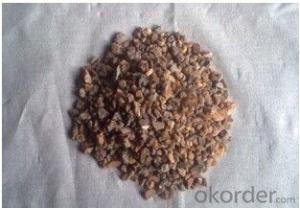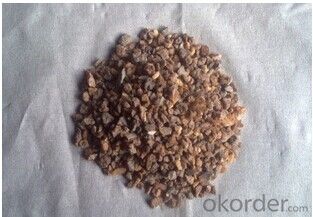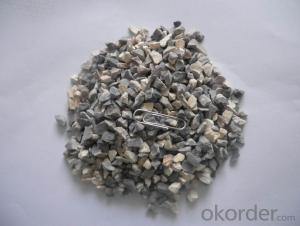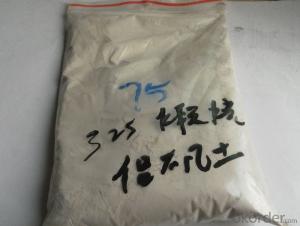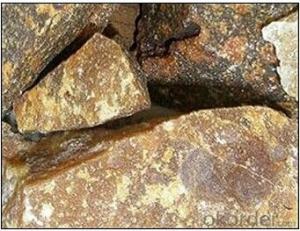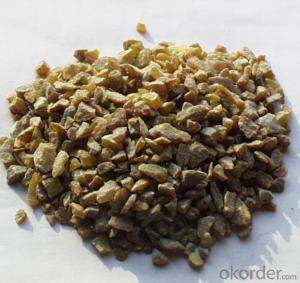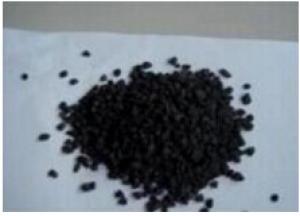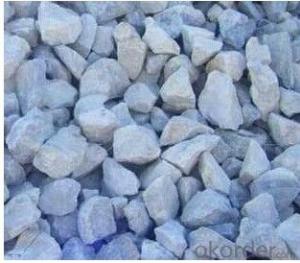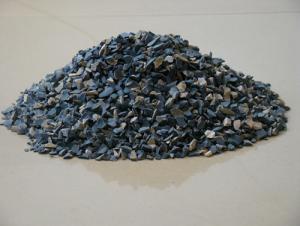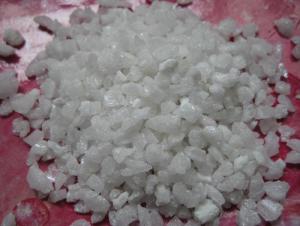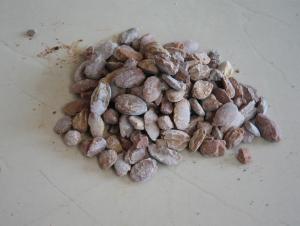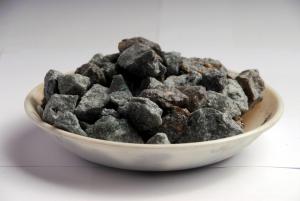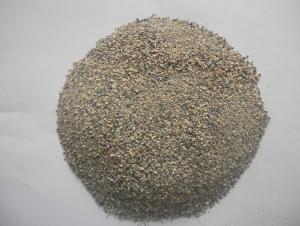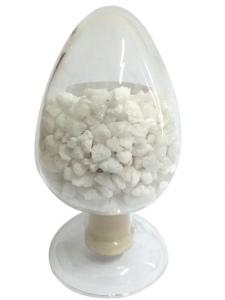Raw Materials for Refractory:Special Electrically Fused Magnesia
- Loading Port:
- China Main Port
- Payment Terms:
- TT OR LC
- Min Order Qty:
- -
- Supply Capability:
- -
OKorder Service Pledge
OKorder Financial Service
You Might Also Like
Fused magnesite sand are manufactured by high purity caustic calcined magnesite through electro-fusing,a part of SiO2,moves to the surface because of the huge difference in the specific which well grown crystals,well crystal perfection and structure homogeneity,excellent chemical stability,good corrosion resistance to slag and high stength at high temperature.it is main raw .material for manufacturing magnesia or magnesiacarbon Bric refractories.The manufactures are mainly used in regenerative chamber in the large scale glass furnace by floating method,electrical furnace,convert furnace,house hold electrical appliances as electrical insulating materials and so on...
Fused Magnesite (Ordinary Grade)
Fused Magnesite (Ordinary Grade) is manufactured through fusing high quality raw magnesite in electric arc furnace with the characteristics of big crystal, dense structure and strong corrosion resistance. As an excellent basic refractory raw material, its MgO content is between 87 – 98%.
Fused Magnesite (Big Crystal)
Fused Magnesite (Big Crystal) is manufactured through fusing high quality calcined magnesite at high temperature in electric arc furnace with the characteristics of complete crystal, dense texture, good high temperature performance and strong corrosion resistance.
Fused Magnesite (Big Crystal) whose MgO content is between 97 – 99% is widely used in refractory industry. Meanwhile, it is also an excellent high-temperature endurable insulating material.
Main products level :
0-1mm;1-3mm; 3-5mm; 0-10mm 50-325 mesh
Electrically fused magnesia has gradually won a place in the special refractories group, owing to its physical superiority over the ordinary grades of dead-burned magnesite. The history of its development dates from the world-war period, when considerable interest was aroused in the sources of supply of magnesite in this country. The economic advantages depend largely on the European situation and the prevailing price for the fused material, but the practical advantages of using a totally shrunk, well-crystallized material are obvious. The crystalline material obtained from various grades of raw material differs somewhat in its physical characteristics, and there is a decided difference in the physical properties between dead-burned magnesite and electrically fused magnesia.
MgO% | 92.0%MIN |
CaO% | 2.0%MAX |
H2O | 0.2%MAX |
SiO2 | 3.0%MAX |
Fe2O3 | 1.0%MAX |
Size | 3-5mm |
- Q: What is the function of refractory material?
- Refractory is a basic material in the field of high temperature technology. Generally, the refractory is used as structural material or lining to resist high temperature in various thermal equipment and high temperature container. In the iron and steel industry and metallurgy industry, coke ovens are mainly composed of refractory materials. Various refractories that meet the requirements are essential in blast furnace for ironmaking, hot stove, all kinds of steel-making furnaces, soaking furnace and heating furnace. Not only the die casting for molten steel needs lots of refractory materials, but also the continuous casting needs some high-quality refractory materials. Without high-quality refractory materials, external refining is also not impossible to achieve. Statistics show that the steel industry is the sector that needs the most refractory. Pyrometallurgy and thermal processing of ferrous metal also needs refractories. All high-temperature furnaces or lining in construction materials industry or other high temperature industries that produce silicate products such as glass industry, cement industry, and ceramics industry must be constructed with refractory materials. All kinds of roasting funaces, sintering funaces, heating furnaces, boilers, flues, chimneys and protective layers in chemical, power and machinery manufacturing industry need refractories. In short, when some kind of structures, devices, equipments or vessels are used under high temperature, they all should utilize refractory to resist the high temperature because those materials will deform, soften and fuse or will be eroded, scoured or broken due to the physical, chemical, mechanical effects, which may stop the operation, affect the production, contaminate processed objects and impact the quality of products.
- Q: How to choose thermal insulation materials for flood heating?
- 1, Select the appropriate floor material suitable for radiant floor heating. The floor radiant heating system mainly transfer heat through the ground concrete and the ground material to the room. Therefore in the heating season the ground material will always be heated during heating season. Therefore, it is better to choose stone materials and compround floor plate insensitive to tenmperature change with good heat dissipation and functions. Currently, wood floor is not suitable for the ground radiant heating system. 2, choose the pipe with anti permeability performance. Plastic floor heating pipe itself has a certain air permeability, if oxygen penetrates in it is prone to oxygen erosion and system's mental device will be eroded, resulting in the risk of leakage. Therefore in order to ensure the reliable operation of the heating system, the selected pipe must have anti oxygen permeation performance, and meet the standard stipulated by the DIN4726 oxygen permeation quantity: and be less than 0.1mg\L.d at 40 C.
- Q: Fire rating of decoration materials
- All light steel keel gypsum board is considered level A; if the wood finishes up to B2 grade fire rating depends on the proportion of the use of wood veneer and the proportion of this wood veneer fire grade, if the proportion of wood veneer is small,it can be considered level A
- Q: What is high alumina refractory?
- It refers to inorganic non-metallic material with refractoriness of higher than 1580℃. Refractoriness refers to the celsius temperature that the cone-shaped refractory sample without load can resist, and under which the sample won't soften and melt down. Refractory material appears together with high temperature technology, and roughly dates from the Middle Bronze age. In the Eastern Han Dynasty (AD25~AD220) of China, fireclay refractories has been used as furnace refractories and saggers for making porcelains. In the early 20th century, refractory material develops toward the direction of high purity, high dense and ultra high temperature products, and meanwhile unshaped refractory and refractory fiber with no need of firing at all and with low energy consumption appear.
- Q: What are the differences between intensive refractory busway and other busways?
- Compact busway is named after its structure, especially referring to busway which is closely laminated between phases and between phase and shell and use thin insulating material to achieve the insulation result. Fire-resistant busway is named after its uses, just as its name implies, for higher fire safety requirements need busway of higher fire resistance level. The structural style of fire-resistant busway can be intensive and of air type, depending on what material it use to resist fire, so there is no direct link between them, but there is a included relationship.
- Q: Can anyone say something about what A-level fire-proof decorative material is?
- Combustion performance rates of decoration materials ratess combustion performance of decoration materials A incombustible B1 flame retardancy B2 flammability B3 high flammability The B1 rate combustion performance of gypsum plaster board and mineral wool acoustic panel absorber installed on steel joist can be used as A-level decoration materials. Inorganic decorative coating applied on the A level substrate can be used as A level decoration materials. Hope you adopt
- Q: Who knows the highest temperature the high-temperature refractory coating can resist?
- When coating the fire-resistant coating on a steel beam of a building, paint film thickness reaching 2mm, and steel beams in the building are on fire, the fire-resistant coating can withstand for two hours. Fire-resistant coating is passive fire protection materials painted on the surface of the protected objects (eg. steel structure) , which can be divided into types of thick, thin, ultra-thin and facing according to the thickness. It can be divided into water-based and solvent-based products by medium. Whatever the structure of the building is, it will collapse if it is on fire for a long time. Fire-resistant coating function as isolation layer on the surfaces of the protected objects, delaying the building collapse time to win over valuable time for rescue and fire fighting. I hope this answer can help you.
- Q: what is the Specifications Grading for Fireproof rubber insulation materials ?
- External insulation materials, welded wire mesh matt external wall insulation, external wall thermal insulation mesh matt. 1,inorganic activel thermal insulation materials 2,silicate?thermal?insulation?material 3,ceramic thermal insulation 4, gelatine powder polyphenyl granule, 5,teel wire gauze picking cement cystosepiment(Estazolam platepowder particles)6 extruded sheetXPX. 7,Rigid polyurethane coating at the scene, Polyurethane insulation board8,rigid polyurethane foam,9EPS foam board roofing materials. 1, a ceramic insulation board 2, xps extrusion board 3, perlite and perlite brick 4, vermiculite and vermiculite brick heating, air conditioning Material: Phenolic resins, polyurethane waterproof thermal insulation integration, sponge rubber, polyethylene, polystyrene foam, glass wool, rock wool Steel material: Polystyrene, extruded sheet, polyurethane panels, glass wool carpets and the like. Five inorganic thermal insulation materials: Foam cement, DY inorganic active insulation system super thin vacuum insulated panel for building external walls .
- Q: Which region use more refractory?
- Steel industry gathering areas use more refractories, for which you can know more details on Jinmeng website.
- Q: how long is the fire endurance of plasterboard?
- fireproof endurance can reach a maximum of 4hours, suitable for a variety of public buildings firewall, and partitions for public exit passageway, reaching standard level of fireproof. the lightweight partition made of gypsum board and steel stud is mainly for dividing architecture space. Rock wool can be filled in the mddle according to its design requirements, using different series of gypsum board, steel stud. the walls may have fire resistance and sound insulation property of various degrees.
Send your message to us
Raw Materials for Refractory:Special Electrically Fused Magnesia
- Loading Port:
- China Main Port
- Payment Terms:
- TT OR LC
- Min Order Qty:
- -
- Supply Capability:
- -
OKorder Service Pledge
OKorder Financial Service
Similar products
Hot products
Hot Searches
Related keywords
